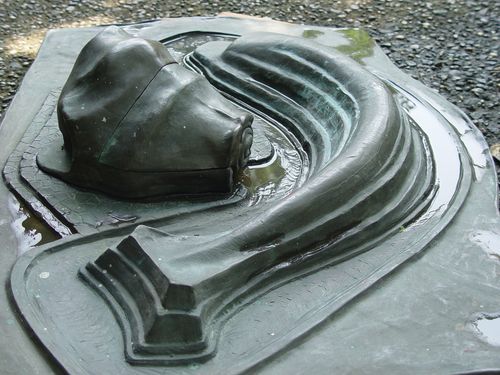Design reformer and utopian thinker Frederick Kiesler
The Exploding Coulisse exhibition shows development and lasting relevance of Wagnerian ideas
Frederick Kiesler was a Ukrainian, Austrian, and American artist. The exhibition “Die Kulisse explodiert” (The Exploding Coulisse) has opened at the Secessionist Villa Stuck in Munich. It features the recently found scale model of Kiesler’s Space Theater, designed in 1930 as part of the new multimedia Festspielhaus for America’s Woodstock Music & Art Fair. The model took inspiration from the Bayreuth theater myth which had become a reality, making the glorious Wagner Theater the venue for the annual opera ritual, called Bayreuther Festspiele. While working on new projects of a universal theater of the future, Kiesler dreamed of another Bayreuth.
Wagnerian Gesamtkunstwerk reflections had to do with a comprehensive restructuring of theatrical space. The architect Gottfried Semper’s design of the future Festspielhaus significantly influenced the development of world theater architecture in its own time already, while Kiesler the theater reformer kept the work going on the Wagnerian utopia Kunstwerk der Zukunft. Uniquely, Kiesler was an artist of many callings, combining in one person architect, designer, painter, philosopher, engineer, and unsurpassed world-class theatrical visionary, but he still is, unfortunately, almost unknown in his native land. The fact that the Ukrainian origins of Frederick (baptized as Julius) Kiesler have never been mentioned in an encyclopedia speaks volumes! Architectural Dictionary and The Great Encyclopedia of Cyril and Methodius call him an American architect, while Wikipedia sees Kiesler as an Austrian, German, and American theatrical designer, artist, theoretician and architect. It is true that the artist started to implement his ideas of the space theater (Raumtheater), and endless, universal theater only after leaving Ukraine. However, he arrived in the United States only in 1926, as an already mature, 36-year-old cultural figure of good standing.
Kiesler was born into a Jewish family in Chernivtsi in 1890, receiving his first artistic impressions in the city’s theater. It was these impressions that prompted him to continue his studies in Vienna, the world’s artistic metropolis at the time. The young artist’s strong creative ascent began with the denial of the traditional theater, while later on, Kiesler radically reformed the theater space, resulting in development stage architecture concepts of his own, called Raumbuehne and Endless Theater. Raumbuehne marked a rejection of the traditional concept of the theatrical proscenium. Kiesler and Doblin built an open vertical spiral-shaped building, allowing the dynamic performance to be held at different levels simultaneously. The audience’s attention was defocused in a circle, creating the illusion of collective participation. Generally, Kiesler did not treat the theater scene as a design object, but as an integral part of Gesamtkunstwerk.
Kiesler’s Raumtheater became a unique example of the reception of Wagnerian Kunstwerk der Zukunft under the terms of the new theatrical aesthetics. The artist’s idea of total space dramatization later took shape of corealism, his very own style.
Kiesler’s emigration to America was related to his plans to implement his theatrical projects. However, the dream to make a grand utopia into reality came true only partially. Most of the artist’s ideas as realized in contemporary theaters have been perceived as Kunstwerk der Zukunft throughout our epoch. Kiesler also failed to find a passionate supporter and generous patron similar to Wagner’s Bavarian king Ludwig the Second. Monumentality of the revolutionary architect’s radical projects of the theater was fantastically expensive, and lack of funding prevented most of his theater buildings’ reconstruction projects from implementation, leaving them as transcendent space utopias of the Space Theater, an imaginary theatrical universe from another reality.
The artist’s most important ideas saw implementation after he had won the New York multimedia projects competition for the summer festival Woodstock Music & Art Fair. His project “The Space Theater Woodstock,” in which the artist dreamed of “a new Bayreuth,” received the first prize in 1931. However, the American stock market crisis of 1929 meant that the Festspielhaus’s construction was indefinitely postponed.
Even so, Kiesler gained wide recognition, bringing him an invitation to the position of art director at the opera theater of the Julliard School, New York’s most prestigious conservatory. He was responsible for set and stage design there from 1933-57 and directed the production of operas by Mozart, Britten, Stravinsky, Milhaud, Dallapiccola, and the American composer George Antheil (1900-59).
The artist’s inventions have remained not just a unique avant-garde project, but an eloquent testimony, too, to the theater as a new philosophy of the universe, space, perfect cosmos, and artistic utopia of the future. Kiesler’s theater visionalism gave rise to the urban development project Raumstadt (space city, City in Space) as an open-air-theater art event.
It is no accident that the early 20th century surrealist architect’s reception of Gesamtkunstwerk resonates today. Kiesler’s motives are manifest in alternative buildings of the Viennese architecture firm Coop Himmelb(l)au, including such projects as the Dalian International Conference Center in China and the BMW Welt in Munich. Kiesler’s Gesamtkunstwerk resonates with contemporary composers’ innovative ideas of total audio dramatization, including Bernd Alois Zimmermann’s ideas of spherical time and Karlheinz Stockhausen’s space-ritual musical continuum. So, Kiesler’s theater reform came to fruition in the work of subsequent generations of artists as “a living organism, consisting of dynamically strained trajectories of various spatial substances,” including that endless plastic substance of human existence.
Adelina Yefimenko is Doctor of Fine Arts, Professor of History, Art Theory and Performing Skills at the Lesia Ukrainka East European National University
Выпуск газеты №:
№37, (2013)Section
Culture





